The next-gen MacBook Pro with Retina Display Review
by Anand Lal Shimpi on June 23, 2012 4:14 AM EST- Posted in
- Mac
- Apple
- MacBook Pro
- Laptops
- Notebooks
The King of All Notebook Displays
For years Apple has been shipping some of the best displays in consumer notebooks, but the MacBook Pro’s Retina Display is in a league of its own. While I never liked the phrase “painted on” in reference to the iPad and iPhone Retina Displays, that’s the best way I can describe the effect the MacBook Pro’s Retina Display has on me. Text really does look painted on. The effect is really the result of two things.
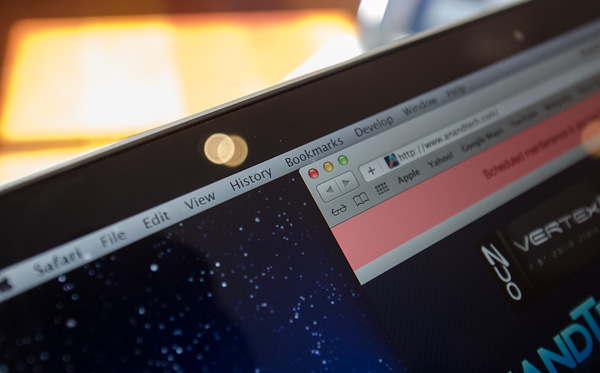
The first is Apple’s removal of its cover glass. LCD panels aren’t particularly attractive, they are ugly squares composed of two pieces of glass and a number of filters/polarizers. To hide the ugly edges, display makers wrap bezels around the display. Most people aren’t fond of bezels so next came a ton of effort to minimize bezel size. An alternative is to simply place a third piece of glass over the entire LCD assembly and make it look as if the bezel and LCD panel are integrated. This outermost layer is known as a cover glass and is what Apple uses on all of its glossy displays. If you’ve ever taken apart a Cinema/Thunderbolt Display or a newer iMac you’ll know that the cover glass is literally just a piece of glass that you have to remove with some suction cups.
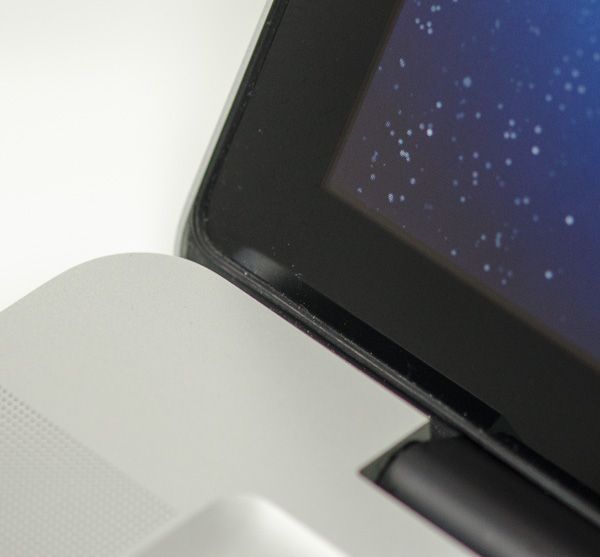
Non-Retina MacBook Pro, notice the gap between the outermost LCD glass and the cover glass
The MacBook Pro’s Retina Display does away with the cover glass and instead uses a fairly unique LCD assembly. There are still two pieces of glass but the outermost glass is actually a different size and shape - it integrates a bezel. By integrating the bezel into the outermost glass in the LCD stack you get the same effect as a cover glass but without the added reflections it introduces.
You also limit the possibility of dust getting trapped between the cover glass and the LCD. The danger is that you no longer have a protective piece of glass in front of your expensive new LCD. If you scratch the display you're scratching the LCD itself. While this has been true for conventional matte displays for a while, it's worth mentioning if you're used to Apple's glossy displays where you did have that added security layer.
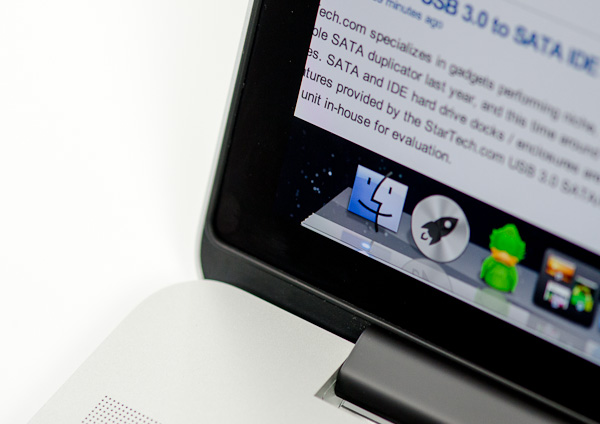
The MacBook Pro with Retina Display, no gap, no cover glass
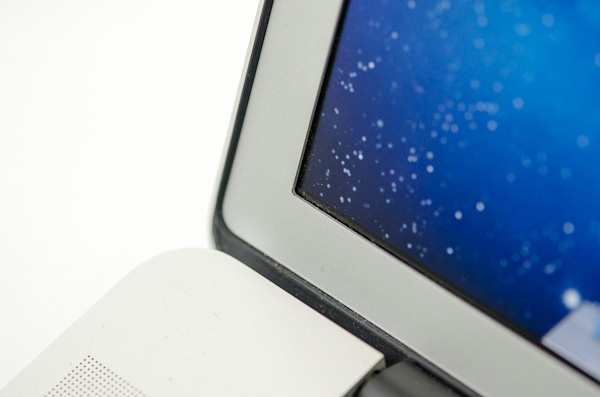
The 2011 MacBook Pro with High-Res Matte display option, no cover glass, top bezel

From left to right: 2010 High Res Glossy MBP, 2012 rMBP, 2011 High Res Matte MBP
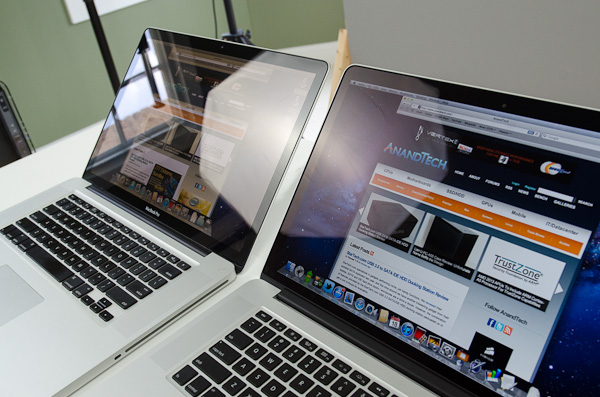
Glare handling indoors - 2011 High Res, Glossy MBP (left) vs 2012 rMBP (right)
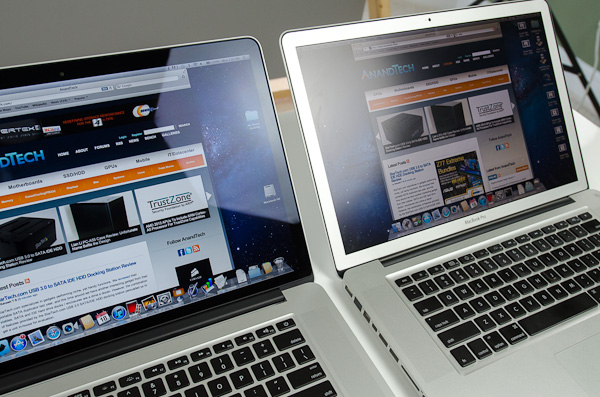
Glare handling indoors - 2012 rMBP (left) vs. 2011 High Res, Matte MBP (right)
The Retina Display is also obviously an extremely high resolution panel at 2880 x 1800. Note that this is 44.6% more pixels than Apple’s 27-inch Thunderbolt Display, and 26.6% more pixels than the 30-inch panels that we’ve loved for so long - all in a 15.4-inch notebook display.
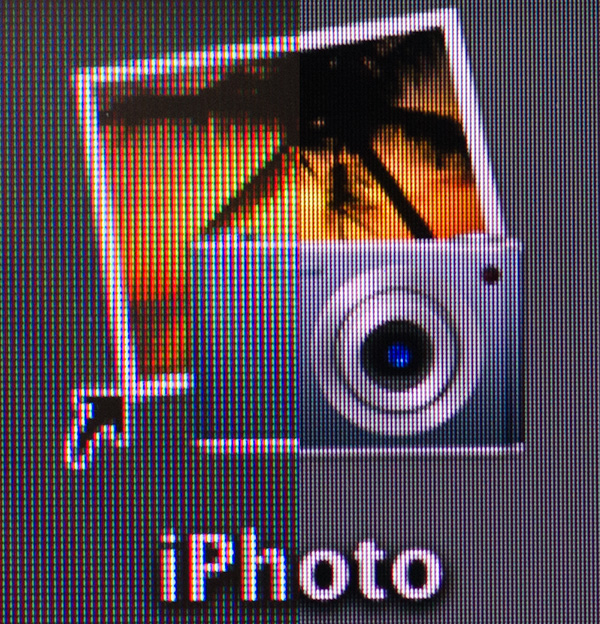
An iPhoto shortcut, High Res 2011 MBP (left) vs. Retina Display MBP (right)
At 220 pixels per inch it’s easily the highest density consumer notebook panel shipping today. At normal viewing distances and even with my face closer than I’m comfortable putting it I simply cannot discern individual pixels.
It’s the combination of these two elements, the removal of the cover glass and the insanely high pixel density that makes everything from text to UI elements just look painted on the new Retina Display. And the effect is gorgeous. I’ve never seen a prettier panel and it’s actually ruined me for pretty much all other displays, notebook and desktop.
While I can appreciate the iPad’s Retina Display, the impact from the MacBook Pro’s display is even more significant. Perhaps it’s because I still spend so much time working on a standard, non-tablet display, but I’m far more excited about this display than anything else Apple has delivered under the Retina moniker.
It’s not just pixel density that Apple has to offer here. Similar to its Retina Displays in the iPhone and iPad, the MacBook Pro’s Retina panel ditches TN in favor of IPS technology. The result is an incredible improvement in viewing angles. On a notebook I don’t spend a lot of time viewing it from far left/right angles, although I see the benefit when I’ve got others huddled around my display. Here the panel performs admirably - you lose brightness at far left/right angles but there’s no perceivable color shift. In fact, the painted on effect is even more impressive at these far left/right viewing angles.
For a single user however the more impressive characteristic is just how good the display looks at vertically off-center angles. I wrote much of the initial parts of this review while on an airplane in coach, which with a 15-inch notebook on my lap means I’m going to be looking at the display at a weird angle to begin with. The thinner rMBP doesn’t do enough to make the airplane usage model any better if the person in front of you decides to recline, but the IPS panel does make the display perfectly usable at the off-center angle you’ll inevitably have to deal with.
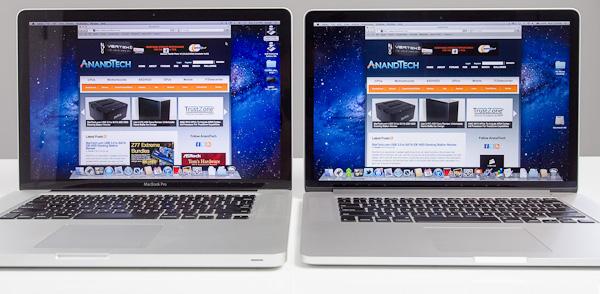
2010 High Res, Glossy MBP (left) vs. 2012 rMBP (right)
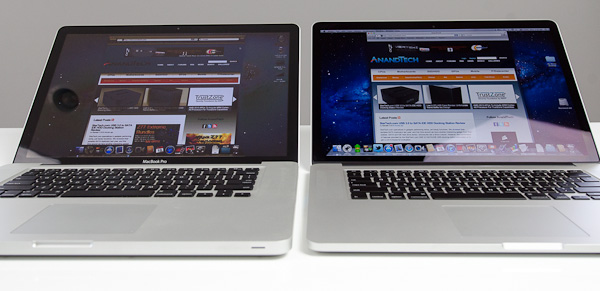
Hello colorshift!
2010 High Res, Glossy MBP (left) vs. 2012 rMBP (right)


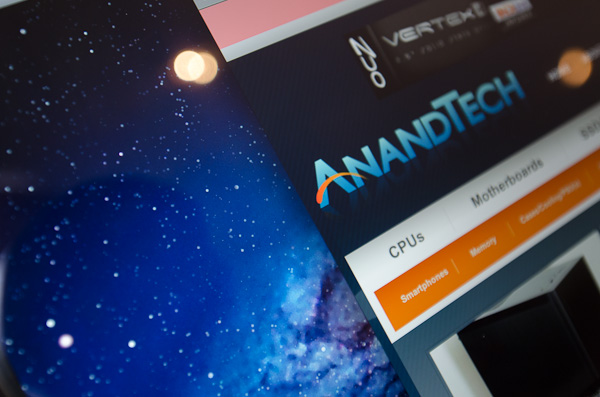
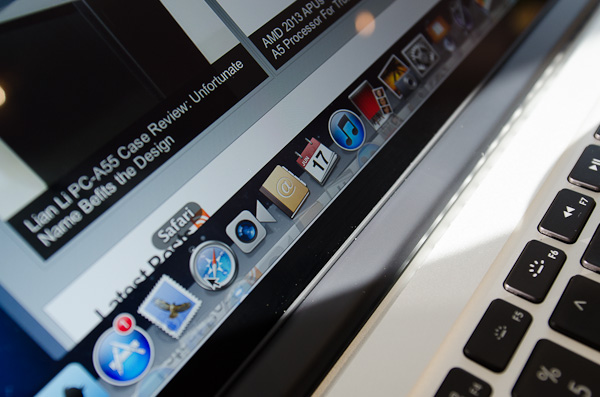
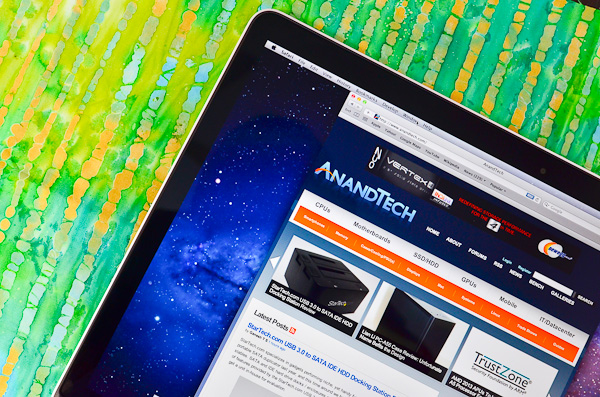
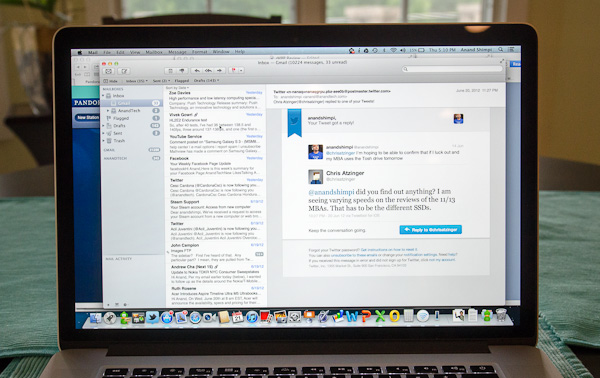
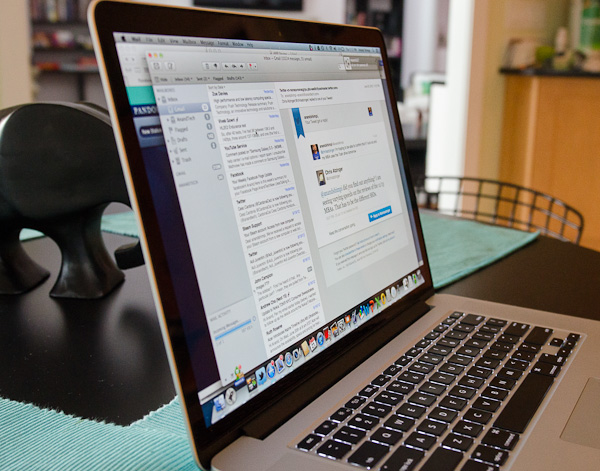








471 Comments
View All Comments
Penti - Saturday, June 23, 2012 - link
W8 doesn't change anything, having one setting for Metro and one for Desktop that works just like before doesn't cut it.Spoony - Saturday, June 23, 2012 - link
I don't think you've been understanding what I've been saying.Quartz is a fully resolution independent drawing layer. It can map to any pixel density necessary. It is incredibly fast and flexible, especially when tied in to technologies like Core Animation, Core Image, and Core Text.
It's also worth noting that Core UI exists in OS X, and has done since 10.5. This is a vector/texture baking engine that draws all interface elements in OS X in a fully resolution agnostic way. This is a very nice, and slick piece of software.
You do make a point, Apple keeps doing this 2x scaling thing. Why?
As it turns out, U/I scaling is a very complex thing. Not only is it a bit difficult to wrap your head around, it's a bit difficult to code against. Everybody isn't about to go build vector assets for their applications. Apple has to meet developers (and its own internal application teams, probably) halfway. Thus the @2x assets. It is a somewhat limiting, although fairly consistent and simple method for enabling bitmap creation in a resolution independent interface.
So you're wrong, OS X does have (and has had) support for full resolution independence. You can scale to your heart's content, from a 600dpi printer to a 72dpi display, at any interface factor.
The question is simply more complex than "does the slider work". Windows does not scale well at all, applications tear, refuse to scale, magnify far too much, render incredibly blurry images and text. The rendering layer is not versatile, nor set up for this kind of usage. Win8 improves matters, but not with as much depth as we'd have hoped.
ananduser - Sunday, June 24, 2012 - link
I know that Apple's Quartz engine is scaling capable the agnostic and traditional way. Just was never good at it for extreme scenarios; a common gripe with macusers demanding better implementation. Windows' similar mechanism was always more efficient especially since Vista(XP's sucked).3rd party apps that don't scale properly have only their devs to blame. I don't know your particular app use on Windows but I can say that you gripes with it are exaggerated or maybe translated from your OSX experience. Battle of the sliders is ultimately a question of correct dev use. 3dmark for instance makes use of their own trademark GUI that does not make use of Win resources. I've always hated that. So does itunes on WIndows or Safari. These will never work right.
The 2x scaling is a rigid compromise. It achieves consistency but not resolution independence. As I said before, resolution independence does not exist as it is idealistic in theory, and abstracts constraints such as scaling factors. If Apple pushes ahead with their low/normal/high scaling presets across their entire line-up, and in the process completely eliminates the notion of changing resolution(as in picking a number from a table) they will achieve a consistent experience like on ios; and it will still not be resolution independence "from a technical pov".
I'm arguing semantics and not the MBP-R which is a spanking machine.
Spoony - Sunday, June 24, 2012 - link
Lots of the software I use on Windows fails hard when you crank that slider up. Photoshop, Illustrator, SAP, iTunes (woe is me), Chrome, Office, etc... a vast majority of the software I want to use does not work correctly. Plus Win7 isn't exactly elegant about scaling artwork, even universal widgets get a little weird looking.And here I agree with you. 2x is rigid, it is not ideal, we would want to pick a resolution and then pick a U/I scaling value to get exactly the pixel density and U/I size that is ideal for our use. I would like that a great deal.
Unfortunately that's not the reality of designing interfaces today. We are moving into new territory here from an execution standpoint, and you can't just go vectorize all your assets and FP-define all of your layout coordinates and transforms overnight.
To make this work, Apple need to meet developers and users halfway. They need to make it simple for the user to select the most comfortable size for elements, while also providing a "we believe this is best" mode. They need to give developers a relatively straightforward way to develop assets for these higher resolution displays, and not force too much layout tweaking.
This is a transitional period. I believe Apple has struck a decent balance. A balance that works and will actually allow this to fly. It isn't the best of all worlds right now, but that day is coming. Certainly what Apple ships today is better than what Microsoft ships today. That difference will also be eroded by time.
ananduser - Sunday, June 24, 2012 - link
I noticed Anand's review update. Windows set on 200% increase, makes the desktop similar to OSX' retina setting. And furthermore Anand also stated that under this state Windows faces the same 3rd party related issues as OSX."To make this work, Apple need to meet developers and users halfway. " One modification...Apple needs to meet "their" developers and "their" users.
"Certainly what Apple ships today is better than what Microsoft ships today."
I'm not sure you want to go far as to compare 2 different OS architectures based on high res panel support alone. This is first and foremost a subjective discussion before an objective one.
ananduser - Sunday, June 24, 2012 - link
Win8 has the best high res support of the market. It's completely panel agnostic(11 inch all the way to Ballmer's wall TV). It's easy to diminish W8, but it is more of a step forward than Apple's traditional "small steps" policy.Spoony - Sunday, June 24, 2012 - link
Only in Metro mode.In "old-style desktop" mode it exhibits the same problems as Win7. So it will require developer effort in the same way Mac OS X will.
Windows 8 is well known to produce very polar reactions. The direction and momentum of Metro development is highly questionable right now. There are a lot of unanswered questions and not a lot of trust in Microsoft's path.
On the flip-side, Apple is shipping a high-res hardware product today with a clear and well known path to high-res execution today. They have a defined timeline to their next OS and a price tag attached. Everything is a known quantity here, and developer support is strong.
Windows 8 will be released in the fall sometime with a presently unknown price and an unknown vector to high-res asset curation.
This is not a post bashing Microsoft or adoring Apple (none of them were). I am plainly stating the way that two different companies have tackled a very complex issue at this moment in time. I deeply hope that Microsoft, Apple, Linux, and 3rd party developers all put forward competitive support for high resolution displays because they are the future, and I'd like to enjoy them.
ananduser - Sunday, June 24, 2012 - link
"Everything is a known quantity here." Apple's biggest advantage."I deeply hope that Microsoft, Apple, Linux, and 3rd party developers all put forward competitive support for high resolution displays" The potential issue is that they all put competitive efforts but different efforts. Each one goes their own way.
wendoman - Saturday, June 23, 2012 - link
That's why Intel QuickSync doesnt work on Mac's? LOLSpoony - Saturday, June 23, 2012 - link
"High-performance H.264 encoding3When you select a standard HD export setting, QuickTime Player takes advantage of hardware video encoding for optimal performance."
"Supported on the following Mac models: iMac (Mid 2011 or newer), Mac mini (Mid 2011 or newer), MacBook Air (Mid 2011 or newer), and MacBook Pro (Early 2011 or newer)."
http://www.apple.com/osx/whats-new/features.html
Apple does things when they're good and ready (for better or worse), and by the looks of things with Mountain Lion they're exposing QuickSync underneath AVFoundation or QTKit.